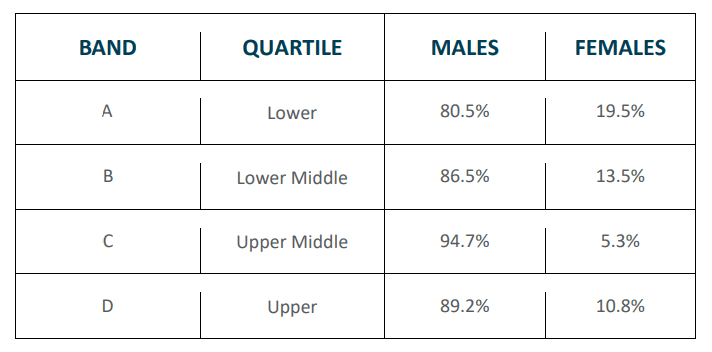Gender Pay Gap Report 2022
Foreward
At Vergo Pest Management Ltd, we know that diversity in gender and all other forms amongst our workforce is critical for building a successful, robust, and sustainable business. We strive to be an employer of choice that
recognises and rewards all talent equally, and we understand the importance of gender equality. This report showcases our commitment to closing the gender pay gap. It highlights the findings of our assessment, the measures we have put in place to address the pay gap, and our plans towards achieving gender pay parity.
Our gender pay gap
This is our annual gender pay gap report for the snapshot date of 5 April 2022.
- Our mean gender pay gap is 10.2%
- Our median gender pay gap is 13.3%
- Our mean gender bonus gap is 55.8%
- Our median gender bonus gap is 89.9%
- The proportion of male employees receiving a bonus is 82.7%, whereas the proportion of female employees receiving a bonus is 85.7%
Pay quartiles by gender
This table shows our workforce divided into four equal-sized groups based on hourly pay rate. The Lower quartile includes the lowest-paid 25% of employees, and the Upper quartile covers the highest-paid 25%.

The percentage of Male to female employees in each quartile is 80.5% or more.
Why do we have a gender pay gap?
We are committed to equal opportunities and treatment for all employees, regardless of sex, race, religion or belief, age, marriage or civil partnership, pregnancy/maternity, sexual orientation, gender reassignment or disability. We have a clear policy of paying employees equally for the same or equivalent work, regardless of their sex (or anything else listed above). We conduct regular pay and benefits audits, provide equal pay training for all employees involved in pay reviews, and evaluate job roles and pay grades to ensure fairness.
We are confident that our gender pay gap is not because we pay men and women differently for the same or equivalent work. Instead, our gender pay gap is because men and women work in different roles, and those roles have different salaries. In addition, we have a heavily male-dominated workforce, which is the norm in the pest control industry.
In the UK, it is also not uncommon for more men to hold more senior positions than women. Men tend to be in higher-paying technical and IT-related roles, while women are likelier to take work breaks to raise children or work part-time in lower-paid positions. This trend is also reflected in our organisation, where most managers and senior management team members are men.
The table above shows our workforce divided into four equal-sized groups based on hourly pay rate. Band A includes the lowest-paid 25% of employees (the lower quartile), and band D covers the highest-paid 25% (the upper quartile). If we had no gender pay gap, each band would have an equal ratio of men to women. However, 19.5% of the employees in band A are women, and 80.5% are men. The percentage of male employees increases throughout the remaining bands, from 86.5% in band B to 89.2% in band D.
How does our gender pay gap compare with others?
At the time of reporting, most of our workforce is operational and male in gender. However, our median gender pay gap is lower than the national average median gender pay gap, which is 14.9% (according to the October 2022 ONS ASHE figures) by 1.6% and has decreased by 12.1% year on year from 27% in 2021 to 13.3% in 2022.
What are we doing to close our gender pay gap?
Although our gender pay gap compares favourably and is currently below the national average median gender pay gap and has improved over the last 12 months, we are committed to doing everything we can to continue to reduce the gap. We know this will be challenging in a male-dominated industry where attracting more women into the sector is difficult, particularly in operational roles, which primarily fall in the lower and lower middle quartiles.
We know achieving a representational balance between male and female colleagues is critical to closing the gender pay gap, and we will continue recruiting women into operational front-line pest control roles and mid-level support and managerial roles. Building our female representation in these roles will create a pipeline of women for future middle and senior manager roles. In support of this, we encourage women to consider front-line pest technician roles by offering foot technician positions on smaller dedicated patches, term-time only and part-time opportunities where we can, to attract working parents who need to work around childcare commitments.
We have launched our new flexible working policy for all employees and have introduced other policies to offer and support a positive work-life balance, including hybrid working, a sabbatical leave policy and a birthday day off benefit.
We also conduct regular pay audits and address any pay disparities that are identified, as well as areas that need improvement to eliminate any gender bias.
In isolation, none of these initiatives will remove the gender pay gap, and it will take some time for a real impact to be seen. However, we will continue to monitor and report on what we are doing to reduce the gender pay gap.
James Gilding, CEO
Vergo Pest Management Ltd
